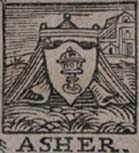- ASHER
- TYRE
 According to Genesis 34:12-13, the tribe of Asher was descended from Asher, the second son of Jacob through Zilpah, handmaid of Leah. Genesis 30:13 described how he received his name, as Leah said, “It is my happiness (b’ashri באשרי ), for the daughters will called me happy”.
According to Genesis 34:12-13, the tribe of Asher was descended from Asher, the second son of Jacob through Zilpah, handmaid of Leah. Genesis 30:13 described how he received his name, as Leah said, “It is my happiness (b’ashri באשרי ), for the daughters will called me happy”. Their territorial allotment at the time of Joshua consisted of the entire western Galilee stretching from the Carmel range in the south to Tyre in what is now, southern Lebanon. According to Joshua 19 beginning at verse 24, Asher’s major cities (in alphabetical order) included the following: Achshaph, Achziv, Alamelech, Ammad, Aphek, Bet Dagon, Beten, Cabul, Hali, Hamon, Hebron, Helkat, Hosah, Kana, Mishael, Ramah, Rehov, Shibhor Libnat, Sidon, Tyre, and Ummah. Today, Sidon and Tyre lie in southern Lebanon.
---TYRE
NOTE: Here, I don’t want this to be seen as me advocating that Israel should take over and annex Tyre (or even Sidon) from Lebanon. Over the centuries, these cities found themselves in Lebanon in which status they remain today. Theoretically, Jews could live there side by side with the indigenous Maronites, descendants of the ancient Phoenicians, were it not for the Arab domination and occupation of the area. Tyre is first mentioned in Joshua 19:29 as one of the northern cities of the territory of Asher, stretching as far north as Sidon. But Asher never really had a firm hold over Tyre and, being so intertwined with neighboring Phoenicia, the city always had a mixed Israelite and Phoenician population and the two groups would get along well. Sometimes, they intermarried. One such product of an intermarriage was Hiram, who became King of Tyre. He was close to both peoples, especially to the Israelites. So much so that he furnished to his friends David (II Sam. 5:11) and Solomon (I Kings 5:1), wood from Mount Lebanon and skilled working men, for their building operations, for which aid he received payment in grain. These materials were used by Solomon to help build the Temple in Jerusalem. He also granted land concessions in Galilee. Solomon's chief architect, also named Hiram, was a Tyrian as well. Tyrian ships in Solomon's service sailed even from the ports on the Red Sea.
In the aftermath of the Greek occupation in the 4th century BCE, Tyre enjoyed a certain liberty until the reign of Augustus, but even so, under the Romans it was the most populous of the Phoenician cities. In 1071, Israel was in the process of being conquered by the Seljuk Turks. This was during the reign of the Jerusalem Academy, Geon Yaacov, under the Gaon Eliahu ben Shlomo. In that year, as the Seljuks were conquering Israel, Eliahu fled, along with most of his assembly, to Tyre, leaving Shlomo Hanasi as acting Gaon in Israel proper, but still under the authority of the new assembly in Tyre. Eliahu’s successor in Tyre was his son Aviatar ben Eliahu. His other son, Shlomo, held the office of Av Bet Din. In 1093, there was conflict with the Egyptian geonate which was trying to impose their rule over the Jews of the entire Fatimid Empire which included Israel. As the Egyptian rabbis were too powerful, Shlomo fled, with part of the assembly, to Hadrak near Damascus, and established a branch of Geon Yaacov there, leaving Aviatar alone in Tyre. With the Crusader conquest in 1099, Aviatar himself, with the rest of the assembly, fled to Tripoli and reestablished the geonate there.
During the Crusader period, Tyre became important owing both to its unusually strong fortifications and to its factories of glass, sugar, etc. The Christians under Baldwin II took it in 1124 and in 1190, Frederick Barbarossa, Emperor of the Holy Roman Empire, was buried in the local cathedral. After Tyre came under full Mameluke control, the place degenerated into a miserable village, especially after the Shi'ite sect of the Matawilah had taken possession of it.
In 1834, when the Jews of Safed were plundered and nearly destroyed by the Arabs and Bedouin, there arrived at Tyre, a ship from North Africa filled with Jewish pilgrims, with the intention settling in Safed. But on hearing about the events there, most decided to stay in Tyre. However, within a generation, this community disintegrated and the people dispersed to other parts of the Lebanon and the Land of Israel.
By 1900, Tyre had a population of 5-6000. Today, its metropolitan area has a population of approximately 174,000. Most are Arab Shiite settlers and a small minority are the indigenous Maronites who often suffer under Arab oppression.
By 1900, Tyre had a population of 5-6000. Today, its metropolitan area has a population of approximately 174,000. Most are Arab Shiite settlers and a small minority are the indigenous Maronites who often suffer under Arab oppression.

No comments:
Post a Comment